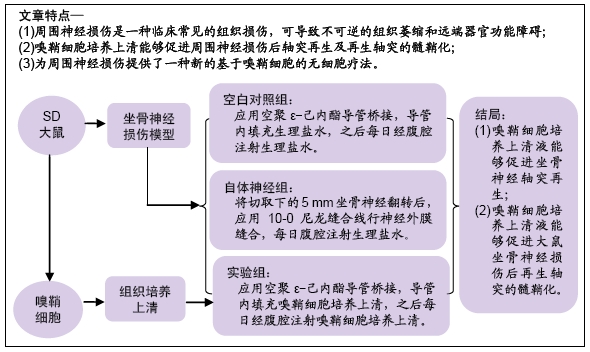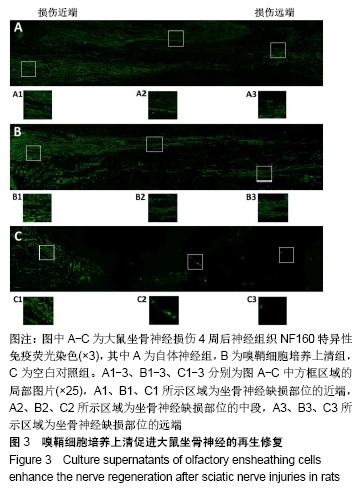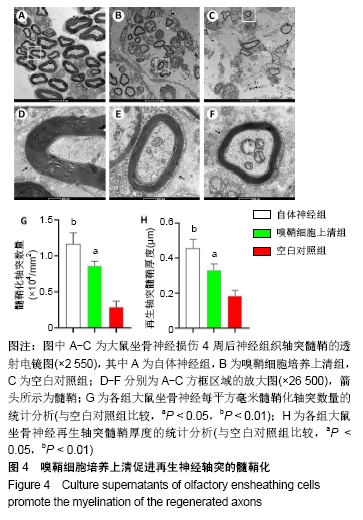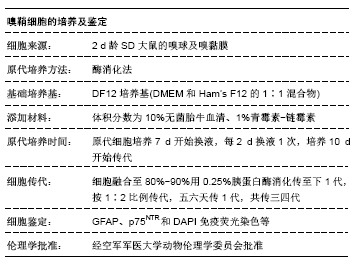[1] PANAGOPOULOS GN, MEGALOIKONOMOS PD, MAVROGENIS AF. The Present and Future for Peripheral Nerve Regeneration. Orthopedics. 2017;40(1):e141-e156.
[2] DONZELLI R, CAPONE C, SGULÒ FG, et al. Microsurgical repair by autografting in traumatic injuries of peripheral nerves: a series of 50 cases. J Neurosurg Sci. 2019. doi: 10.23736/S0390-5616.19.04572-7. [Epub ahead of print]
[3] GARG K, SINHA S, SATYARTHEE GD, et al. Microsurgical Outcome of Post-traumatic Peripheral Nerve Injuries: An Experience of 23 Cases and Review of Literature. Turk Neurosurg. 2016;26(2):297-301.
[4] GU L. Construction of Chinese peripheral nerve society and progress in repair and reconstruction of peripheral nerve injury. Zhongguo Xiu Fu Chong Jian Wai Ke Za Zhi. 2018; 32(7):786-791.
[5] HUANG L, ZHU L, SHI X, et al. A compound scaffold with uniform longitudinally oriented guidance cues and a porous sheath promotes peripheral nerve regeneration in vivo. Acta Biomater. 2018;68:223-236.
[6] FARONI A, MOBASSERI SA, KINGHAM PJ, et al. Peripheral nerve regeneration: experimental strategies and future perspectives. Adv Drug Deliv Rev. 2015;82-83:160-167.
[7] KUBIAK CA, KUNG TA, BROWN DL, et al. State-of-the-Art Techniques in Treating Peripheral Nerve Injury. Plast Reconstr Surg. 2018;141(3):702-710.
[8] 文俊张,宝林杨,怡果刘,等.移植微囊化嗅鞘细胞对P2X2、P2X3受体介导神经病理性疼痛影响的实验研究[J].中华解剖与临床杂志, 2017, 22(1): 58-63.
[9] WANG YZ, MENG JH, YANG H, et al. Differentiation-inducing and protective effects of adult rat olfactory ensheathing cell conditioned medium on PC12 cells. Neurosci Lett. 2003;346 (1-2):9-12.
[10] RADTKE C, KOCSIS JD. Olfactory-ensheathing cell transplantation for peripheral nerve repair: update on recent developments. Cells Tissues Organs. 2014;200(1):48-58.
[11] RAO YJ, ZHU WX, DU ZQ, et al. Effectiveness of olfactory ensheathing cell transplantation for treatment of spinal cord injury. Genet Mol Res. 2014;13(2):4124-4129.
[12] GOULART CO, ÂNGELO DURÇO DF, DE CARVALHO LA, et al. Olfactory ensheathing glia cell therapy and tubular conduit enhance nerve regeneration after mouse sciatic nerve transection. Brain Res. 2016;1650:243-251.
[13] GÓMEZ RM, SÁNCHEZ MY, PORTELA-LOMBA M, et al. Cell therapy for spinal cord injury with olfactory ensheathing glia cells (OECs). Glia. 2018;66(7):1267-1301.
[14] 揭勇,符策岗,韩庆斌.嗅鞘细胞和间质干细胞用于治疗脊髓损伤的研究进展[J].海南医学,2017,28(22):3709-3711.
[15] 姜泳,迟晓飞,邹喜军,等.重复经颅磁刺激联合嗅鞘细胞移植治疗脊髓损伤[J].中国组织工程研究,2017,21(1):98-102.
[16] MUNISWAMI DM, THARION G. Functional Recovery Following the Transplantation of Olfactory Ensheathing Cells in Rat Spinal Cord Injury Model. Asian Spine J. 2018;12(6): 998-1009.
[17] GU J, XU H, XU YP, et al. Olfactory ensheathing cells promote nerve regeneration and functional recovery after facial nerve defects. Neural Regen Res. 2019;14(1):124-131.
[18] WANG T, CONG R, YANG H, et al. Neutralization of BDNF attenuates the in vitro protective effects of olfactory ensheathing cell-conditioned medium on scratch-insulted retinal ganglion cells. Cell Mol Neurobiol. 2011;31(3):357-364.
[19] GU M, GAO Z, LI X, et al. Conditioned medium of olfactory ensheathing cells promotes the functional recovery and axonal regeneration after contusive spinal cord injury. Brain Res. 2017;1654(Pt A):43-54.
[20] KHANKAN RR, GRIFFIS KG, HAGGERTY-SKEANS JR, et al. Olfactory Ensheathing Cell Transplantation after a Complete Spinal Cord Transection Mediates Neuroprotective and Immunomodulatory Mechanisms to Facilitate Regeneration. J Neurosci. 2016;36(23):6269-6286.
[21] 蒋锐,於子卫.细胞外基质在周围神经修复组织工程学中应用的研究进展[J].听力学及言语疾病杂志, 2018, 26(5): 556-560.
[22] ASSINCK P, DUNCAN GJ, HILTON BJ, et al. Cell transplantation therapy for spinal cord injury. Nat Neurosci. 2017;20(5):637-647.
[23] LIADI M, COLLINS A, LI Y, et al. The Impact of Tissue Storage Conditions on Rat Olfactory Ensheathing Cell Yield and the Future Clinical Implications. Cell Transplant. 2018; 27(9):1320-1327.
[24] 王自强,高春林,周亮亮,等.嗅鞘细胞在脊髓损伤治疗中的研究进展[J].中国脊柱脊髓杂志,2017,27(12):1139-1143.
[25] TORRES-ESPÍN A, HERNÁNDEZ J, NAVARRO X. Gene expression changes in the injured spinal cord following transplantation of mesenchymal stem cells or olfactory ensheathing cells. PLoS One. 2013;8(10):e76141.
[26] LIN N, DONG XJ, WANG TY, et al. Characteristics of olfactory ensheathing cells and microarray analysis in Tupaia belangeri (Wagner, 1841). Mol Med Rep. 2019;20(2):1819-1825.
[27] FENG L, GAN H, ZHAO W, et al. Effect of transplantation of olfactory ensheathing cell conditioned medium induced bone marrow stromal cells on rats with spinal cord injury. Mol Med Rep. 2017;16(2):1661-1668.
[28] NASH HH, BORKE RC, ANDERS JJ. New method of purification for establishing primary cultures of ensheathing cells from the adult olfactory bulb. Glia. 2001;34(2):81-87.
[29] FENG S, ZHUANG M, WU R. Secretion of nerve growth factor, brain-derived neurotrophic factor, and glial cell-line derived neurotrophic factor in co-culture of four cell types in cerebrospinal fluid-containing medium. Neural Regen Res. 2012;7(36):2907-2914.
[30] 张洁元,李越,姚东东.嗅鞘细胞移植对大鼠脊髓挫伤后急性期巨噬细胞向M2亚型极化的影响及意义[J].中华神经医学杂志, 2018,17(2):130-135.
[31] AU E, RICHTER MW, VINCENT AJ, et al. SPARC from olfactory ensheathing cells stimulates Schwann cells to promote neurite outgrowth and enhances spinal cord repair. J Neurosci. 2007;27(27):7208-7221.
[32] YUI S, FUJITA N, CHUNG CS, et al. Olfactory ensheathing cells (OECs) degrade neurocan in injured spinal cord by secreting matrix metalloproteinase-2 in a rat contusion model. Jpn J Vet Res. 2014;62(4):151-162.
[33] BARTON MJ, JOHN JS, CLARKE M, et al. The Glia Response after Peripheral Nerve Injury: A Comparison between Schwann Cells and Olfactory Ensheathing Cells and Their Uses for Neural Regenerative Therapies. Int J Mol Sci. 2017;18(2): E287.
[34] 王晓玉,王楠,郑遵成,等.嗅鞘细胞移植调节星形细胞活性促进急性脊髓损伤大鼠神经功能恢复[J].中国矫形外科杂志, 2018, 26(6):548-554.
[35] YAO D, ZHANG J, LI B, et al. Regulatory effect of olfactory ensheathing cells on inflammatory cytokines in repair of rat sciatic nerve defect. Zhongguo Xiu Fu Chong Jian Wai Ke Za Zhi. 2016;30(12):1538-1544.
[36] LÓPEZ-VALES R, GARCÍA-ALÍAS G, FORÉS J, et al. Increased expression of cyclo-oxygenase 2 and vascular endothelial growth factor in lesioned spinal cord by transplanted olfactory ensheathing cells. J Neurotrauma. 2004;21(8):1031-1043.
[37] CHUNG RS, WOODHOUSE A, FUNG S, et al. Olfactory ensheathing cells promote neurite sprouting of injured axons in vitro by direct cellular contact and secretion of soluble factors. Cell Mol Life Sci. 2004;61(10):1238-1245.
[38] DENG Y, WU LMN, BAI S, et al. A reciprocal regulatory loop between TAZ/YAP and G-protein Gαs regulates Schwann cell proliferation and myelination. Nat Commun. 2017;8:15161.
[39] ZHAO Z, LI X, LI Q. Curcumin accelerates the repair of sciatic nerve injury in rats through reducing Schwann cells apoptosis and promoting myelinization. Biomed Pharmacother. 2017; 92:1103-1110.
[40] 高群,宁昕杰,王辉.MicroRNA和雪旺细胞自噬与周围神经再生修复的研究进展.[J].中国病理生理杂志, 2018,34(8):
527-1531.
[41] KRÄMER-ALBERS EM, BRETZ N, TENZER S, et al. Oligodendrocytes secrete exosomes containing major myelin and stress-protective proteins: Trophic support for axons? Proteomics Clin Appl. 2007;1(11):1446-1461.
|





